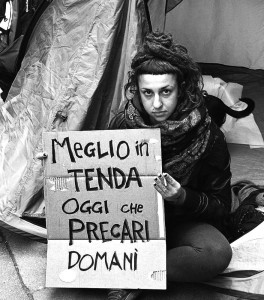 UK and US occupations seized the headlines of global media, making their tent communities a symbol of a new wave of resistance. In other parts of Europe however, Occupy is taking different shapes and creating many diverse realms of the possible.
UK and US occupations seized the headlines of global media, making their tent communities a symbol of a new wave of resistance. In other parts of Europe however, Occupy is taking different shapes and creating many diverse realms of the possible.
In Rome, the initial group of roughly 200 people that camped in Santa Croce square was not able to insert itself into the broader social context and gradually vanished. Yet, the powerful occupy banner has triggered several initiatives and galvanised others, which are infused with the values of the movement.
On the 15th of October, the date of the global uprising, a direct action group “Draghi Ribelli” (Rebel Dragons), launched a three day occupation outside the Italian National bank, in which over 500 people took part. Following that, through a horizontal decision making process of open assemblies, the group decided not to embrace the ‘tent city’ format.
Instead of one prolonged occupation, Draghi Ribelli are organising several flash occupations with different themes. An example is Occupy Christmas, for which actions are focused in traditional Roman shopping areas. These would serve as a reminder of the surprise that awaits all Italians underneath the Christmas tree: a spending cuts package no one voted for.
Simultaneously, different citizen groups have begun to reclaim abandoned spaces and turn them into sites where ideas are not only shared, but put into practice.
A case in point is the occupation of an old theatre building. This building, once a cornerstone of Roman culture, had fallen into disuse and was being co-opted by private companies involved in money laundering scandals to create bingo rooms.
The group, who have now taken over this space, not only restored its public cultural role, but turned it into a space that serves the community. The building now hosts several cultural events (all absolutely free), a radio station and also an array of workshops, in which people analyse and debate the role of culture as a tool for education and emancipation.
Fernando, one of the occupiers, explains “It has become not only a site of convergence for people, but also a meeting point among institutions and citizens, without opportunistic intermediaries”. He then adds, “it has also breathed fresh air into the area (a relatively degraded area of Rome), bringing the square to life once again “. There are now several occupations of cultural spaces in Rome and throughout Italy.
Simultaneously driven by the issues of welfare and privatisation, students and precarious workers have taken over disused buildings. These spaces are being used to experiment with new models of society by providing free accommodation, providing Italian classes for migrants for two euros, free Wi-Fi areas and many other services useful to the community. These new projects go beyond the traditional concept of a social centre. The open and accessible nature of these buildings & sites makes them places where the global struggle is internalized into the daily lives of ordinary citizens.
Occupy has taken many and varied shapes in Rome, conjugating a global desire to territorial specificities. As argued by Jin, one of the activists involved in Puzzle, “If one determinate format works in Spain it doesn’t necessarily need to work in the same exact way everywhere else”.
After all, what is the most powerful attribute of occupy the tents or its underpinning values?
The notion of self-empowerment. The idea of not waiting for change from above, but being the first in taking action. This has allowed people to bypass traditional hierarchies, creating a struggle focused on a democracy of common goods. This is what has made Occupy so powerful. Allowing for the creation of inclusive and fluid spaces whose character is continuously evolving; shaped by the variety of people traversing them and transforming those people at the same time.




